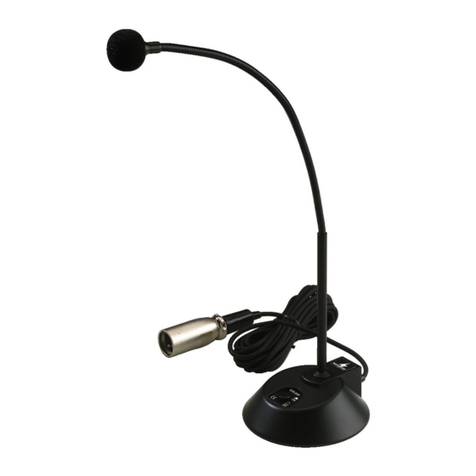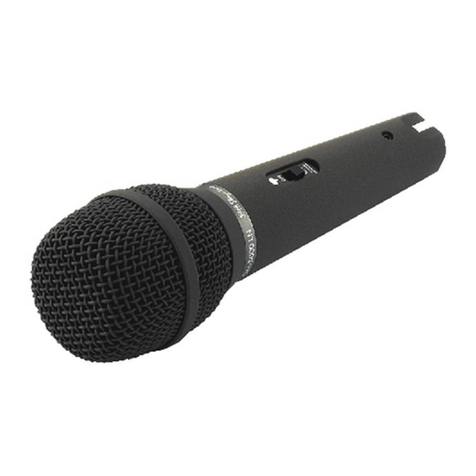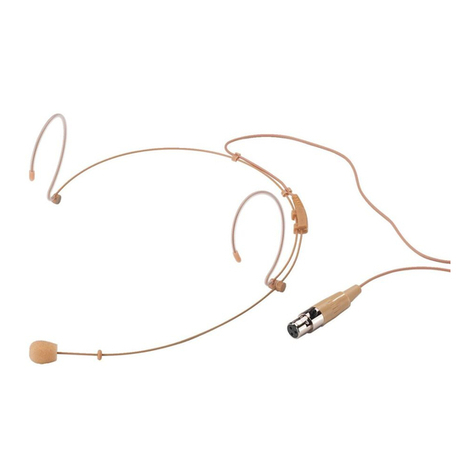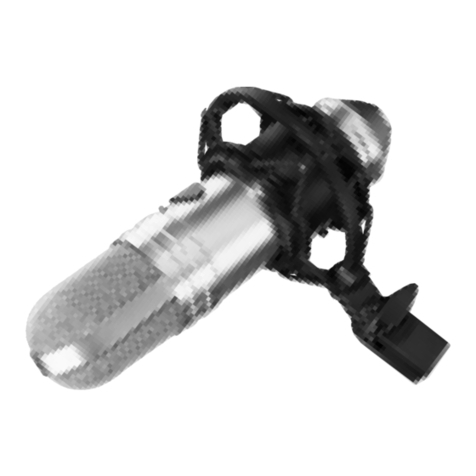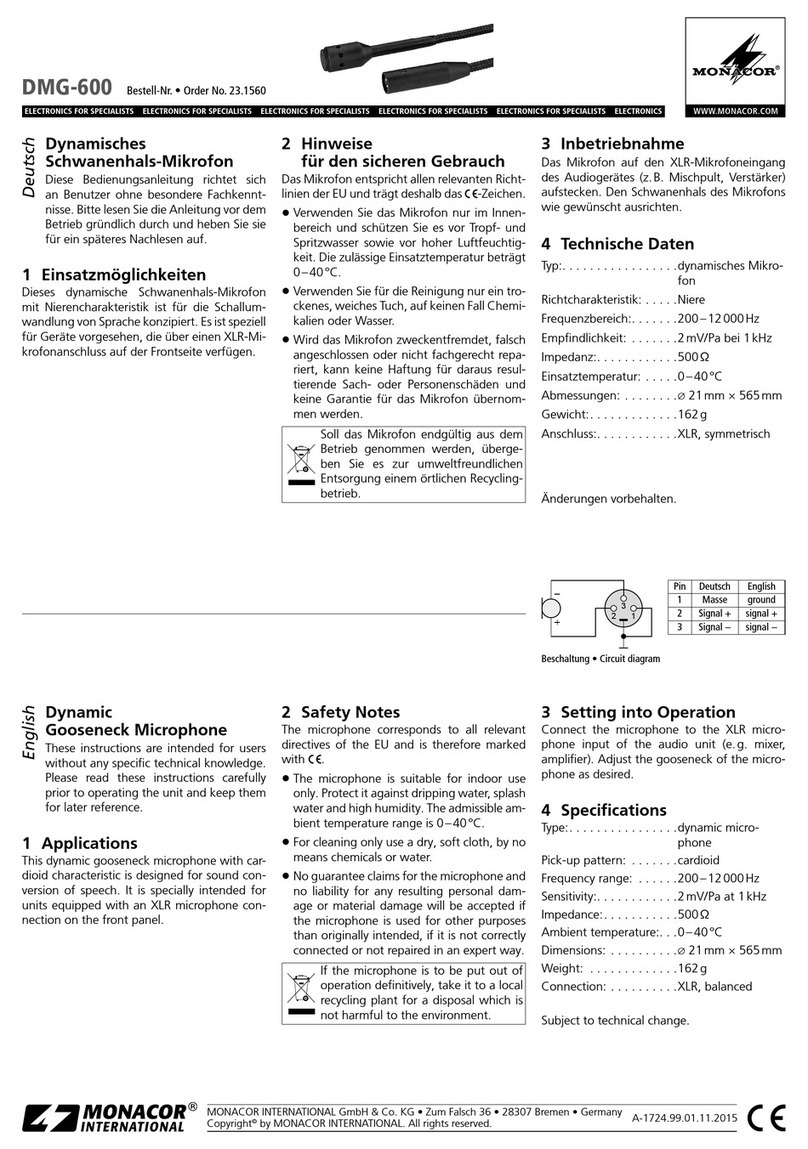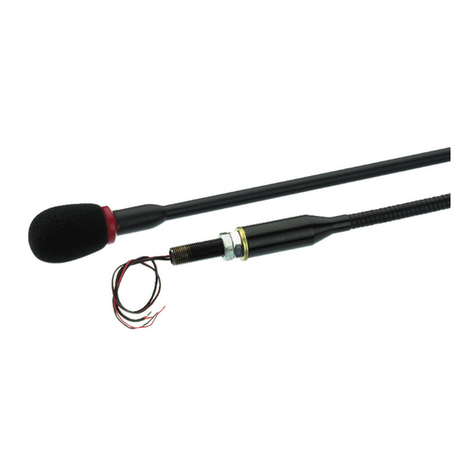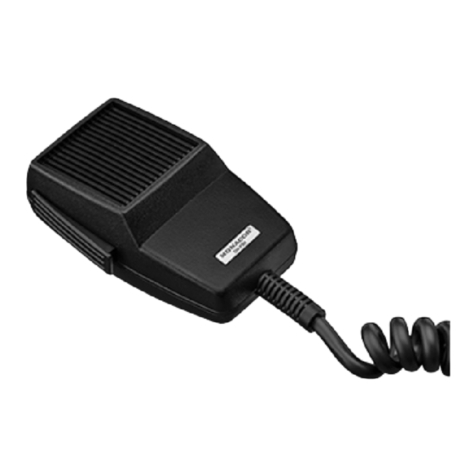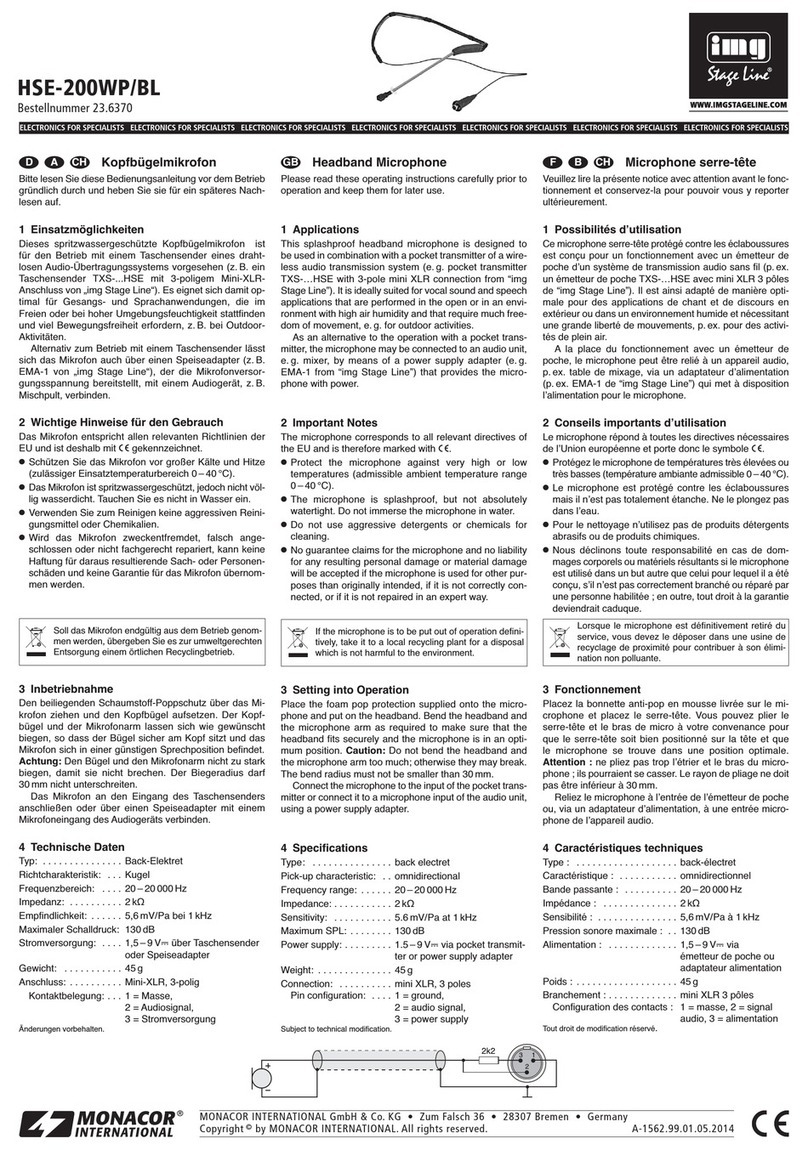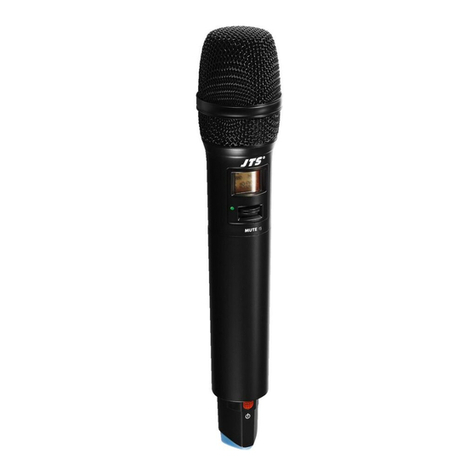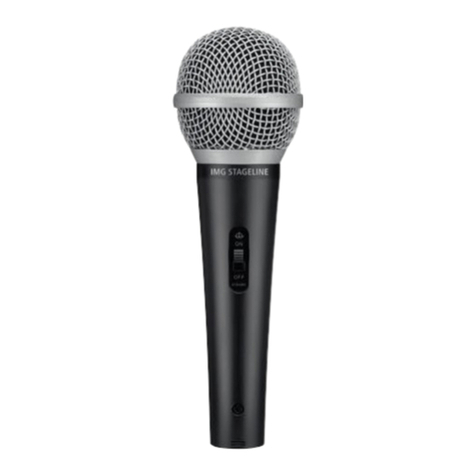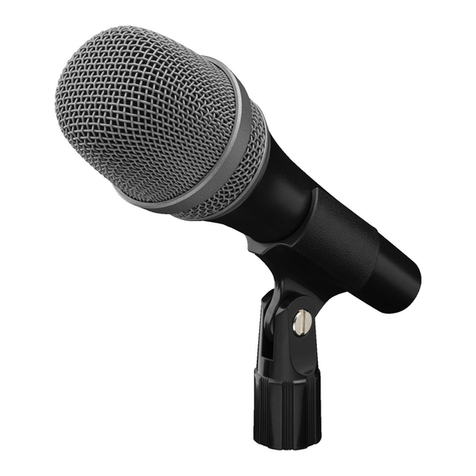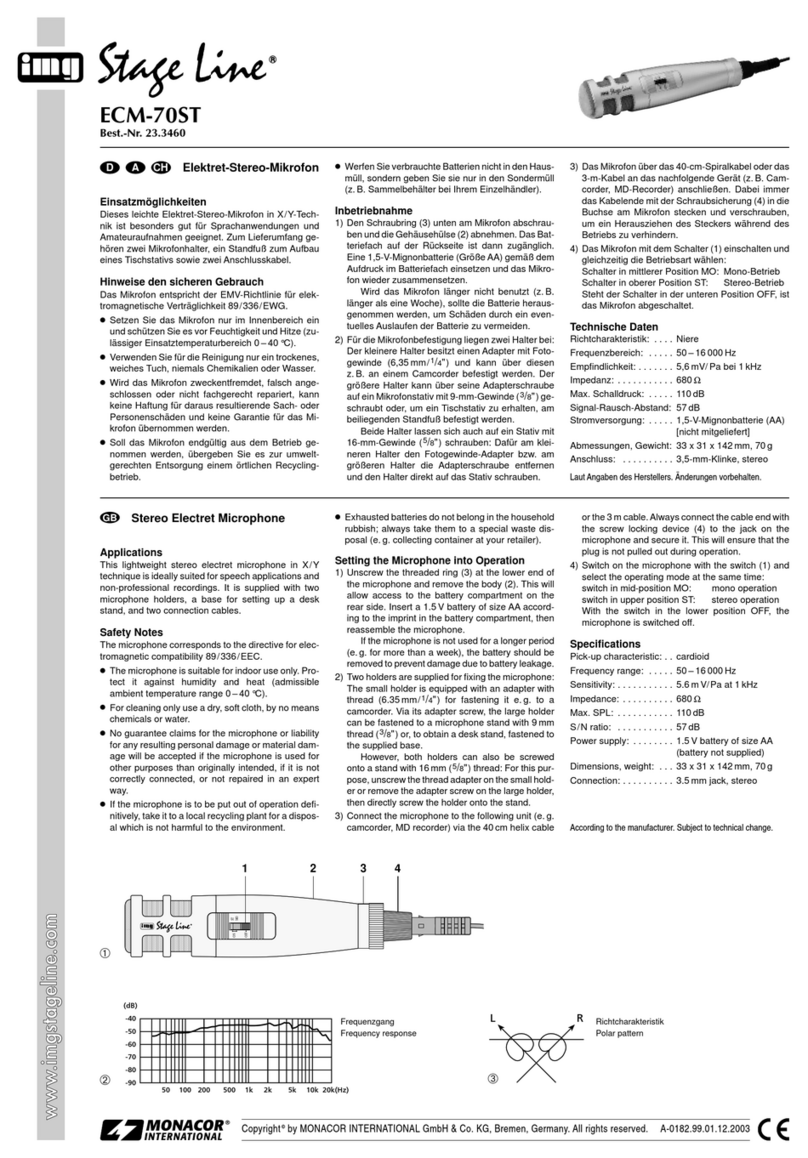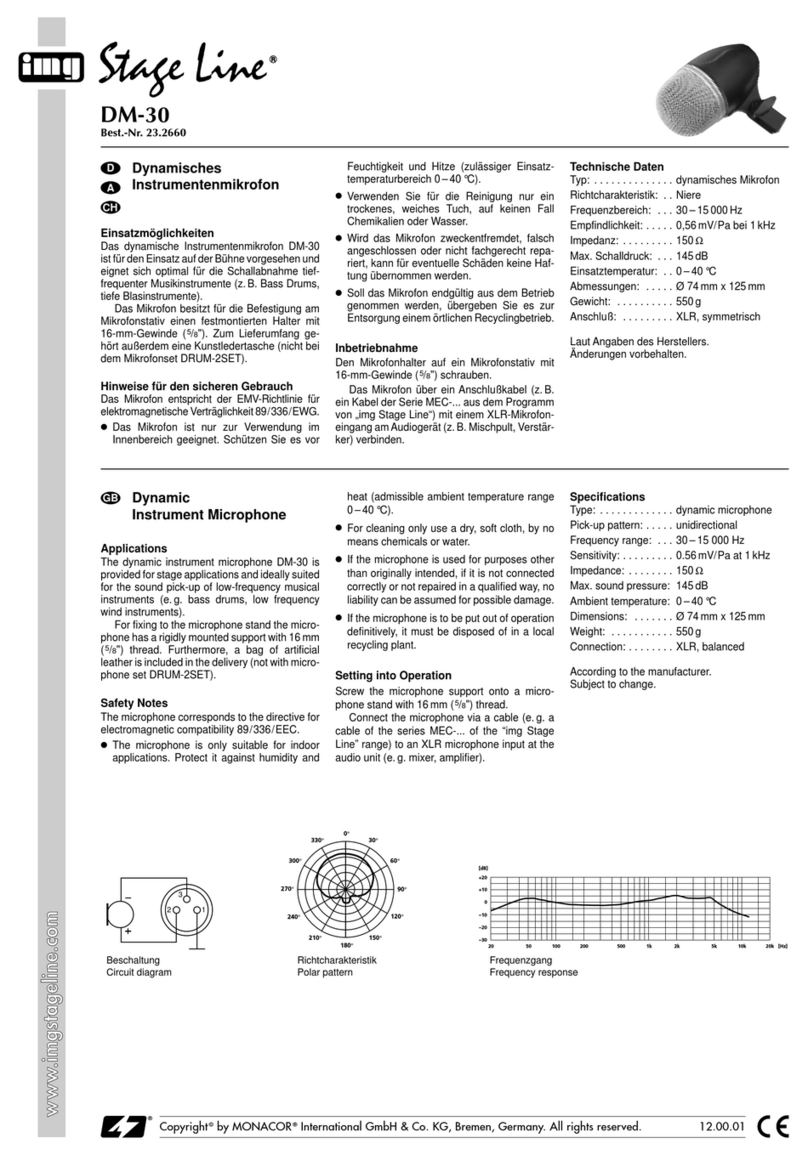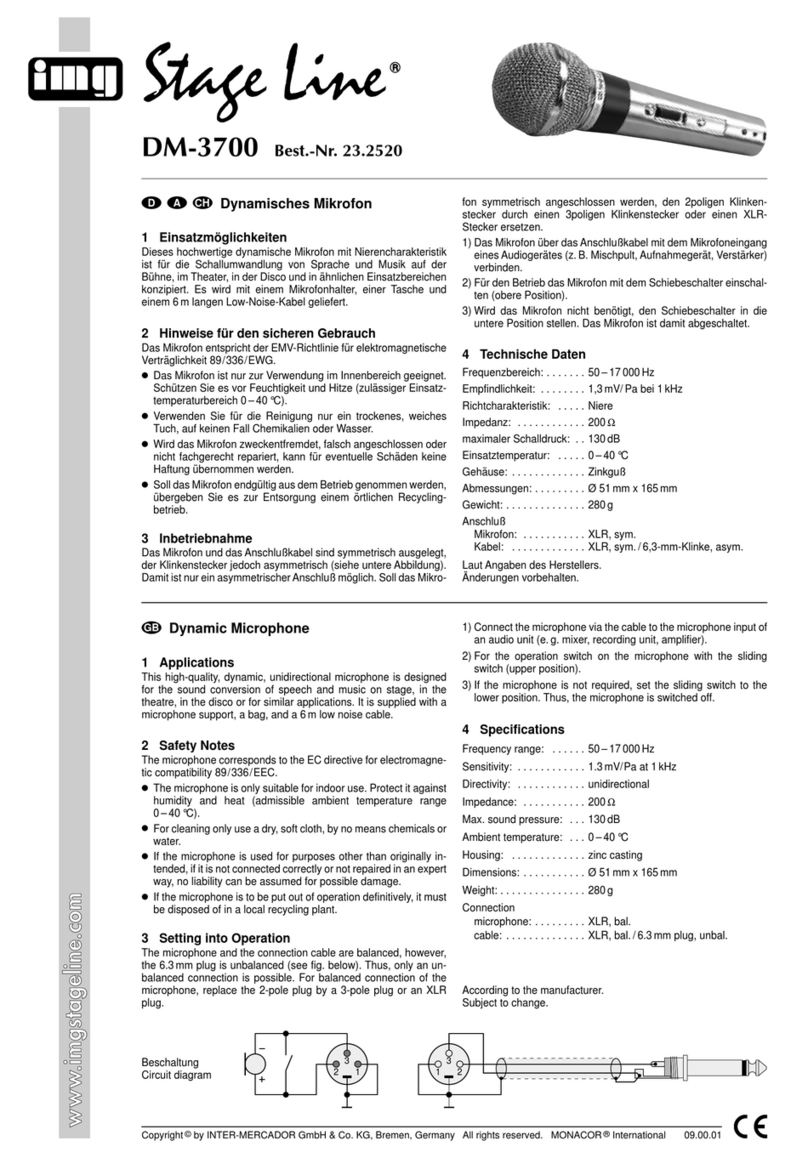DM -030
Best.-Nr. 23.5870
wwwwww..iimmggssttaaggeelliinnee..ccoomm
Microphone dynamique
pour harmonicas
Veuillez lire la présente notice avec attention
avant le fonctionnement et conservez-la pour
pouvoir vous y reporter ultérieurement.
1 Possibilités dʼutilisation
Le DM-030 est un microphone dynamique pour
prise de son dʼinstruments, plus particulièrement
pour lʼamplification dʼharmonicas. Il a un corps
métallique robuste, une capsule avec suspen-
sion caoutchouc à faible rétroaction et une bon-
nette anti-pop intégrée. Grâce à sa forme courte
et ergonomique, il peut être tenu dans la main
avec lʼharmonica pour un son typique de harpe
blues.
2 Conseils importants dʼutilisation
Le microphone répond à toutes les directives im-
portantes de lʼUnion européenne et porte donc le
symbole .
GLe microphone nʼest conçu que pour une utili-
sation en intérieur. Protégez-le de lʼhumidité et
de la chaleur (plage de température de fonc-
tionnement autorisée : 0 – 40 °C).
GPour le nettoyage, utilisez uniquement un chif-
fon sec et doux, en aucun cas de produits chi-
miques ou dʼeau.
GNous déclinons toute responsabilité en cas de
dommages matériels ou corporels résultants
si le microphone est utilisé dans un but autre
que celui pour lequel il a été conçu, sʼil nʼest
pas correctement branché ou sʼil nʼest pas ré-
paré par une personne habilitée ; en outre, la
garantie deviendrait caduque.
3 Utilisation
1) Reliez le micro via le cordon livré à lʼentrée
dʼun amplificateur instrument. Pour le bran-
chement à lʼentrée haute impédance dʼun am-
plificateur à tubes, il est recommandé dʼinsé-
rer un convertisseur dʼimpédance.
Si le micro doit fonctionner à une entrée
symétrique par exemple de table de mixage,
utilisez un cordon symétrique avec con-
nexions XLR (par exemple de la série MEC
de “img Stage Line”).
2) Tenez le micro dans la main pendant que
vous jouez et orientez-le vers les ouvertures
arrières de lʼharmonica lorsque le son est
émis.
Lorsque le microphone est définitive-
ment retiré du service, vous devez le
déposer dans une usine de recyclage
adaptée pour contribuer à son élimina-
tion non polluante.
3) Pour éviter les effets larsen, veillez à ce que le
microphone ne soit pas trop près du haut-par-
leur ou orienté vers lui, le volume ne doit éga-
lement pas être réglé trop fort. Si besoin, di-
minuez lʼamplification dʼentrée sur lʼamplifica-
teur ou la table de mixage.
4 Caractéristiques techniques
Type convertisseur : . . . dynamique
Caractéristique : . . . . . . cardioïde
Pression sonore
maximale : . . . . . . . . . . 135 dB
Sensibilité : . . . . . . . . . . 2,5 mV/Pa à 1 kHz
Impédance : . . . . . . . . . 250 Ω
Sortie : . . . . . . . . . . . . . XLR
configuration contact : 1 = blindage
2 = signal +
3 = signal
-
Cordon branchement : . 5 m avec fiche jack
6,35 mâle 2 pôles
Dimensions : . . . . . . . . ∅48 mm × 93 mm
Poids : . . . . . . . . . . . . . 165 g
Tout droit de modification réservé.
Microfono dinamico
per armonica a bocca
Vi preghiamo di leggere attentamente le presenti
istruzioni prima della messa in funzione e di con-
servarle per un uso futuro.
1 Possibilità dʼimpiego
Il DM-030 è un microfono dinamico per strumenti
musicali ed è adatto in modo particolare per am-
plificare il suono di armoniche a bocca. Possiede
un corpo robusto di metallo, una capsula con
feedback ridotto su un supporto di gomma e una
protezione anti-pop. Grazie alla struttura corta,
ergonomica, è facile tenerlo in mano, insieme al-
lʼarmonica a bocca, per il tipico sound bluesharp.
2 Avvertenze importanti per lʼuso
Il microfono è conforme a tutte le direttive rile-
vanti dellʼUE e pertanto porta la sigla .
GUsare il microfono solo allʼinterno di locali. Pro-
teggerlo da umidità e calore (temperatura
dʼimpiego ammessa fra 0 e 40 °C).
GPer la pulizia usare solo un panno morbido,
asciutto; non impiegare in nessun caso pro-
dotti chimici o acqua.
GNel caso dʼuso improprio, di collegamenti sba-
gliati o di riparazione non a regola dʼarte del
microfono, non si assume nessuna responsa-
bilità per eventuali danni consequenziali a per-
sone o a cose e non si assume nessuna ga-
ranzia per il microfono.
3 Messa in funzione
1) Collegare il microfono con lʼingresso di un am-
plificatore per strumenti musicali servendosi
del cavo di collegamento in dotazione. Per il
collegamento con lʼingresso ad alta impe-
denza di un amplificatore a valvole si consiglia
lʼinserimento di un trasformatore dʼimpedenza.
Se il microfono deve funzionare con un in-
gresso bilanciato, p. es. di un mixer, usare un
cavo bilanciato con connettori XLR (p. es.
della serie MEC di “img Stage Line”).
2) Prendere in mano il microfono mentre si suona
lʼarmonica a bocca e orientarlo verso le aper-
ture posteriori di propagazione del suono.
3) Per evitare il fischio di feedback, fare in modo
che il microfono non si trovi troppo vicino al-
lʼaltoparlante, che non sia orientato verso lo
stesso e che il volume non sia troppo alto. Se
necessario, ridurre lʼamplificazione allʼin-
gresso dellʼamplificatore o del mixer.
Se si desidera eliminare il microfono
definitivamente, consegnarlo per lo
smaltimento ad unʼistituzione locale per
il riciclaggio.
4 Dati tecnici
Tipo di trasduttore: . . . . dinamico
Caratteristica
direzionale: . . . . . . . . . . cardioide
Pressione sonora max.: 135 dB
Sensibilità: . . . . . . . . . . 2,5 mV/Pa con 1 kHz
Impedenza: . . . . . . . . . 250 Ω
Uscita: . . . . . . . . . . . . . XLR
Contatti: . . . . . . . . . . 1 = schermatura
2 = segnale +
3 = segnale
-
Cavo di collegamento: . 5 m con jack 6,3 mm a
2 poli
Dimensioni: . . . . . . . . . ∅48 mm × 93 mm
Peso: . . . . . . . . . . . . . . 165 g
Con riserva di modifiche tecniche.
Réponse en fréquence • Risposta in frequenza
Diagramme polaire (à 1 kHz)
Diagramma polare (con 1 kHz)
®
MONACOR INTERNATIONAL GmbH & Co. KG
•
Zum Falsch 36
•
28307 Bremen
•
Germany
Copyright
©
by MONACOR INTERNATIONAL. All rights reserved. A-1173.99.02.10.2012
F
I
B CH
